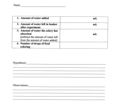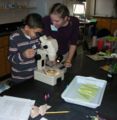Colorful Celery and Carnations
| Instant wiki maker | Making handouts | Editing tips |
Biology In Elementary Schools is a Saint Michael's College student project from a course that ran between 2007 and 2010 and fully described in this book chapter. The student-created resources have been preserved here for posterity. Link under 'toolbox' for printer-friendly versions of the exercises. Click on handouts to print full resolution versions. Please see Wikieducator's disclaimer, our safety statement, and the Creative Commons licensing in English and in legalese.
Student worthiness
tried and trusted
We got this experiment from the website: http://www.sciencefairadventure.com/ProjectDetail.aspx?ProjectID=162
Primary biological content area covered
- Scientific Method (hypothesis & observation)
- Plant survival / transpiration
Materials
Materials for teacher use
- Blade (to cut cross section of celery - for teacher use only)
- Dissecting Microscope (1 for viewing for each group)
- petri dish
Materials for individual student use
- Beakers
- Celery
- Carnations
- Food Coloring
- Water
Handouts
Picture of flower, given to students to color and label.(Figure 1)
Data sheet to help students organize their observations and thoughts.(Figure 2)
Description of activity
This activity is used to teach second graders the process of transpiration in plants. By the end of this lesson they should be able to clearly label the parts of a plant and understand how plants obtain nourishment. They will also be able to make connections between plants’ needs and human needs.
Lesson plan
Opening question
- What do plants need to survive?
Activity
- Hand out materials to students
- Students will fill beaker with 150 mL of water that they measure themselves, and record in a table.
- They will add between 5 and 10 drops of food coloring to the water. (They can add color of their choice) Record amounts in table.
- Students will then put the celery into their individual beakers with the leaves sticking out at the top. (the bottoms of the celery stalks will be pre-cut by the teacher to save time)
- Before any results have begun to show, the students will be asked to formulate their own hypothesis on what will take place. They will record this on a data sheet (fig 1).
- While waiting for the process to begin, the book, “Jack’s Garden” will be read to them and then have them label the parts of a plant on the given handout (fig 2).
- The children will then observe what has been happening to their celery while they have been busy. They will then record the information on their data sheet(fig1).
- An example of a celery stalk and a carnation which have already undergone this process will then be displayed to the students along with an overview of the transpiration process.(see below)
- A previously prepared slide of a cross-section view of a celery stalk will then be put under a microscope for each students to view.
- Wrap up with any questions, and start cleanup!
Overview/discussion of transpiration
- What did you observe?
- Do you know why this happens?
- Do you know what evaporation is?
- Evaporation is the process of conversion of a liquid to a gas; requires energy input
- Transpiration is the process of evaporation of water molecules from leaves, stems, and other plant parts
- The water moves through xylem
- Xylem is a part of a plant. It has sturdy tubes formed by connected walls of dead cells that conduct water and solutes. Kind of like plant veins
- Water inside the xylem is pulled upward by air’s drying power, which creates a continuous negative pressure called tension
- The tension extends all the way from leaves to the roots which is how the water in the beaker gets all the way up to the leaves.
Potential pitfalls
- Not enough time to see the level of the water change, therefore the students were not able to fully complete the math connection. They were only able to measure the starting level of the water.
- Ran out of the blue food coloring, because we allowed the students to choose their own colors.
- Not enough time to distinguish the difference between amount of food coloring. For example a comparison between a student who used 6 drops of food coloring versus a student who used 10 drops.
- We could eliminate this problem by either preparing the cups with coloring before, or establishing a set amount of drops for each student.
- A lot of our issues arose due to the 20 minute time limit. The results of this experiment would be seen more clearly given more time.
Math connections
- The students will meausure the amount of water in the beaker before and after the experiment to find the difference or the amount of water absorbed by the plant. This relates to math beause it allows the students to work with numbers by measuring and practice subtraction to figure out the amount of water that has been absorbed.
Literature connections
- Cole, H.; 1997,;Jack’s Garden; HarperCollins Childrens Books.Idea for use of this book from, http://www.eduref.org/Virtual/Lessons/Science/Botany/BOT0202.html
Connections to educational standards
VT State Standards
- S:2, Students demonstrate their understanding of predicting and hypothesizing.
- S:4, Students demonstrate their ability to conduct experiments.
Mater Christi's Core Standards for Science
- CS:4, Identify elements of habitat- (food, WATER, shelter, and space)
- Plant soaks up the water through its roots to nourish itself
- CS:5 Physical characteristcs of plants and Students will learn that all living things have identifiable characteristics necessary for survival.
- Will easily see the veins or “xylem” with colored water moving through them.
- Also the color will move through into the pedals, stem, and other parts of the plant
- CS:1 Relate a plant to working human body
- Use of Scientific method
Next steps
- displacement of water is a lesson that can be taught with this because many students noticed the water level rose when celery was placed in the cup
- different parts of the microscope
- color lessons (color wheel)
Reflections
- having the students document their observations it allowed the students to have a better understanding of the experiment and process of transpiration.
- it was unexpected that the students clearly saw the results in a short amount of time
- as previous knowledge the students knew what a hypothesis was and what plants need for survival
- using a pre made example of celery and a carnation that cleary showed the results helped with students' overall understanding of the concept
- Picture Gallery
Citations and links
Colorful Celery. 2007. Science Fair Adventure. 16 Jan. 2009 <http://www.sciencefairadventure.com/ProjectDetail.aspx?ProjectID=162>.
We got this experiment from the website: http://www.sciencefairadventure.com/ProjectDetail.aspx?ProjectID=162








